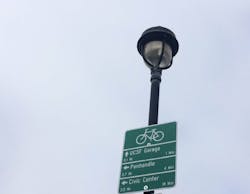San Francisco Celebrates 22nd Annual Bike to Work Day
The San Francisco Municipal Transportation Agency (SFMTA) has joined the San Francisco Board of Supervisors, the San Francisco Bicycle Coalition, other city partners and business leaders to celebrate the 22nd annual Bike to Work Day. The event celebrates and promotes bicycling for transportation, with San Francisco organizing one of the largest Bike to Work Day events in North America.
Two new bike barometers and a new bike wayfinding system were unveiled for the first time today.
“Bike ridership has continually increased throughout the City, and that’s a win for everyone as San Francisco grows in people, jobs and housing,” said Mayor Ed Lee. “We will continue to make the necessary investments to make sure we continue to grow bike ridership with better bike infrastructure and infrastructure for our entire transportation network that will help us reduce congestion on our roads, reduce pollution and create safer streets for everyone.”
To mark this year’s Bike to Work Day, the SFMTA launched two new initiatives to show its support and commitment to promoting biking in San Francisco. The agency recently installed two new, visible automated bike “barometers” that will count people biking as they cross the counters at northbound Valencia between 16th and 17th streets, and westbound Market between 9th and 10th streets. Bike barometers both help the city compile 24/7, year-round data on bike ridership, as well as raise awareness of the growing numbers of people biking in San Francisco. San Francisco’s first bike barometer was installed on eastbound Market between 9th and 10th streets in May 2013. Last year, that counter logged over 1 million bike trips for the entire year, representing a 25 percent increase in bike ridership at that location over 2014.
This week, the SFMTA also unveiled San Francisco’s new bike wayfinding system in the Inner Sunset neighborhood, with plans to roll out 1,200 new signs citywide over the next two years. The new signage system was launched in the Inner Sunset as the neighborhood is a connecting point to many other city destinations, such as Golden Gate Park, Ocean Beach and bike routes that lead to downtown. The new wayfinding system is more intuitive and readable, which will help familiarize people with San Francisco’s expansive bike network and better identify the best routes to destinations citywide.
“The SFMTA is making 2016 a landmark year for bicycling in San Francisco. This year, we are starting construction on projects that will build 22 miles of new and improved bikeways,” said Ed Reiskin, SFMTA director of transportation. “These projects won’t just improve biking, they also include elements that increase pedestrian safety, create a more organized roadway for people driving, and help make transit more reliable.”
A key element supporting the increase in bicycling in San Francisco is the SFMTA’s continued work to make biking better. Other SFMTA efforts that have happened since 2015 include:
- Completed at least 23 projects to increase safety and comfort for people biking
- Constructed and/or upgraded 14 miles of bikeways
- Grown the San Francisco bikeway network to a system spanning 434 miles
- Implemented a variety of bikeway projects that make riding a bike easier on key corridors, such as 13th Street, Bay Street, Sloat Boulevard, Folsom Street, Oak Street and Fell Street
- Initiated key steps to start construction on major streetscape projects that will improve biking on Masonic Avenue, 2nd Street and Polk Street.
- Observed a 184 percent growth in bicycle ridership since 2006 at the same, overlapping 19 intersections in the city as part of the SFMTA’s 2015 Bicycle Count Report.
- Counted an 8.5 percent increase in weekday bike commuters from 2014 to 2015, which is an increase of 200,000 new bike trips
“As a city, SF bikes for a number of reasons. We bike for the environment. We bike for our pocketbooks. We bike for the fun and freedom of it,” said Margaret McCarthy, interim executive director of the SF Bicycle Coalition. “SF bikes because we care about the health and wellbeing of our communities, and that has never been more true than it is today.”
